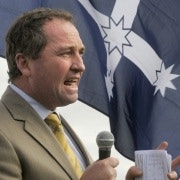Milne's power balance
Christine Milne's ascension to one of the most powerful positions in Australian politics – controlling the balance of power in the Senate – saw the Greens senator described as a hardliner and uncompromising.
That was the opinion of one unidentified Labor figure. But it was an observation that informed much of the mainstream media's coverage of Milne's replacement of Bob Brown as Greens leader.
Given Milne's political history, the statement was bizarre. If it was a warning shot at the new Greens leader from a government keen to establish the upper hand over her, it's likely to fail: the Greens are currently polling at the same sort of levels that saw them pick up four extra senate seats and a House of Representatives seat in 2010.
Like Brown, Milne has extensive Parliamentary experience -- far more than any other party leader in Parliament. She spent nine years in the Tasmanian Parliament, five of them as leader (succeeding Brown there as well), supporting both Liberal and Labor minority governments. Indeed, she had more experience than Brown in working with governments in a balance of power role.
So much for "hardline" and "uncompromising".
Her experience has been important in shaping her approach to achieving outcomes. In a long interview with The Power Index, she told us one of her preferred mechanisms for reaching compromise is through cross-party committees like the multi-party committee on climate change that last year yielded the carbon pricing package.
They work, she says, because they bring in outside, apolitical experts to contribute to the process. Independent input creates a space absent from head-to-head negotiations that allows politicians to adjust their positions and change their minds on issues without losing face or feeling they've undermined their own authority.
The climate change committee, adds Milne, also enabled her to get a sense of Julia Gillard. While she doesn't know her well, Milne says the two women now know each other sufficiently enough to be able to get straight to the point when talking; and she likes Gillard's directness in being clear about what she is able or willing to offer in negotiations and what she can't or won't, and the fact she always delivers what she agrees.
Milne's path into politics was that taken by an ever-shrinking number of major party MPs: through community activism, starting with the Franklin Dam. She entered the Tasmanian parliament after a successful campaign against a pulp mill in Wesley Vale, east of Devonport (Milne had been a high school teacher in Devonort; after becoming leader, she was criticised by both the Riverview-educated Barnaby Joyce and The Australian, which has called for the destruction of the Greens for being insufficiently rural).
Community activism requires its own skills, including being able to bring disparate people across a community together in often difficult circumstances. The parallels with balance of power politics are clear. Like Brown, the contrast between Milne and an increasingly professionalised cadre of inexperienced major party MPs is significant.
However, more than Brown, Milne articulates a comprehensive philosophy. With a week to prepare for Brown's retirement announcement, Milne's ensuing media blitz centred on fusing a broader economic narrative, with less focus on traditional economic indicators and more on quality of life issues like health, education and equality of opportunity, with sustainability for regional economies, which is where the Greens have been working in recent years to develop their electoral strength.
Milne plainly sees agricultural communities as having a natural interest in sustainability and climate change issues, as well as a shared interest in much stronger regulation of coal mining and coal seam gas. These are the sort of issues she has already lived and breathed before entering politics.
What she lacks, of course, is being Bob Brown, who has defined the Greens federally since 1996. As plenty of profiles have noted, Milne presents a more conservative and restrained figure than Brown. But Brown also carried unquestioned authority within the party.
The party's parliamentary representation is now dramatically bigger than for most of Brown's time, and if the party's vote holds at current levels, will increase further in the Senate at the next election (which should enable the Greens to retain the balance of power even in the face of an Abbott landslide).
Growing Parliamentary numbers inevitably create some potential for division, although the tensions that were endlessly predicted by the media around NSW senator Lee Rhiannon – another Green with significant parliamentary experience, incidentally – have resolutely failed to eventuate.
There are plenty of predictions of the Greens' post-Brown demise. But they overlook the extent to which the Greens is a brand unto itself, separate from that of its individual members. Polling from before the last election suggested that Greens voters were far more likely than Labor or Liberal voters to identify their reason for voting Greens as because of policies or dislike of the other parties, than personal identification with leaders or dislike of other leaders.
But the Greens are also a party keen to expand, which means Milne will face yet another variant of the challenge of uniting disparate interests.
This article was first published by The Power Index on July 24.
















